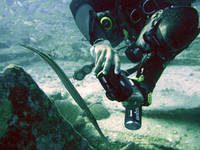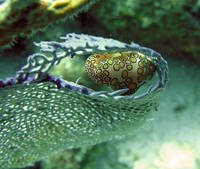April 12, 2005
The divers’ non-vacation. April 1-12, 2005
April 1st. Finally we reached Fort Lauderdale! After more than two months aboard the ship, the diving crew – Mar, Houssine and I – got permission to take a short one-week vacation to rest. After several attempts to get a reasonably-priced flight to Jamaica, Puerto Rico or Cuba, we ended up deciding to drive to the Florida Keys.
So we thought: “since we’re going to be near a reef, let’s go diving there”. At that very instant, though we didn’t realize it then, our vacation was over. We put our diving clothes and gear in the car, and when I say “diving gear”, I am talking about: flippers, masks, vests, regulators, neoprene wetsuits and cameras… for three.

On April 8th, with the trunk and back seat full, we headed off toward Key West. They had recommended that we visit this place, because they told us it was “marvelous”, but it didn’t take us long to become disappointed. We arrived in Key West at about 7 in the evening, and we stayed at the “Blue Lagoon”, a motel on the highway into town. We had dinner, and why we were contemplating a thunderstorm since I hadn’t seen one for a long time, we decided to try to dive the next day. After the storm and the wind that blew during the night, we had to postpone our diving plans until the next day.
Finally the first dive. We set out on the boat we had hired from one of the many local scuba diving companies, accompanied by 20 other tourists aboard. They cast us into the water like a flock of sheep without any control or safety measures. On the two dives we did, we were able to confirm that the reef was quite damaged by the hurricanes that pummel this part of the planet, but also in large part because of the excess in poorly-controlled recreational diving and the pollution coming from the “supertourist” key. We observed coral predators such as: parrotfish, the “flamingo tongue” chiton and fire coral invading sea fans. It was a good image of how mass development that is not very controlled of a tourist spot like Key West can cause serious damage to natural ecosystems, in this case a coral reef.
After this “revealing” underwater experience, they recommended that we go to Key Largo, another one of the keys on the way to Miami, with a company called “Ocean Divers”. So we set off for Key Largo, already the 10th, with our rental car and all our stuff still wet from the day before.
Incredibly enough, we found the scuba shop with hardly any trouble at all. They were much better organized, and much more serious about working; you could tell right off. This time they even asked us for our diving licenses! They explained to us that the next day they had planned two dives at 7:30 a.m. at a shipwreck (sunken ship) and another at a reef, which was enough to convince us and book our reservations. We spent that night resting and watching TV in the hotel room since we had almost forgotten what that was.

Up and Adam at 6:30 a.m.! Time to prepare the cameras and scuba gear. At 8:30 a.m. on the ship with another 6 divers (it is not peak season in Key Largo) and at 9 in the water. Before us was a large shipwreck, sunk a few years ago on purpose, with coral that was still small. In spite of that, you could already see numerous fish perfectly adapted to the new artificial reef between 15 and 30 meters deep. We got out of the water, and at 10:15 a.m. we got back in in the shallow reef area (6-8 meters) covered with sea fans, fire coral, soft coral, a school of fish, 4 spotted eagle rays, parrotfish, pigfish and many more that filled the spot with marine life; a perfect place for photographers and underwater cameras.
After these two dives, we could not wait to see the two sunken ships that were awaiting us the next day.
April 11th Once again at 7:30 a.m. and raring to jump into the water, and a little later, we confirmed that it was worth getting up early. The first wreck, a cargo ship some 25-30 meters below had also been sunk a few years ago and the coral were still “under development”. The second one, a wooden ship that had sunk due to natural causes in 1942, converted into a completely developed artificial reef full of marine fauna. Large numbers of well-conserved coral and fish; we were happy to see that. This was a clear example of how there can be sustainable development of tourism in recreational diving areas: you just need a bit of common sense and interest in protecting our seas.
After this “non-vacation”, on the 12th we came back to the Ranger because they told Mar that her editing computer had a glitch, and like the saying goes: “two heads are better than one”… Isn’t that the way it went?

